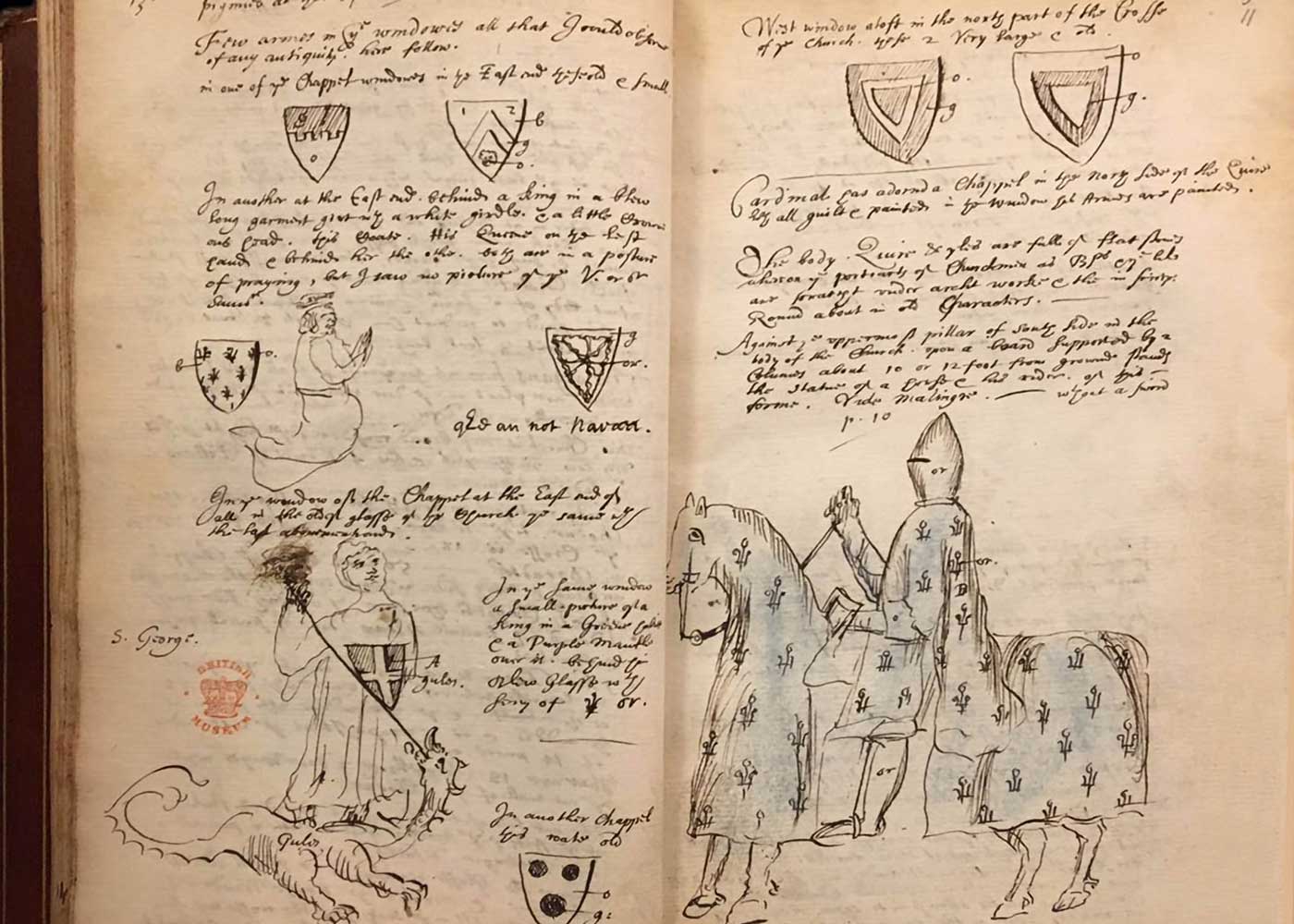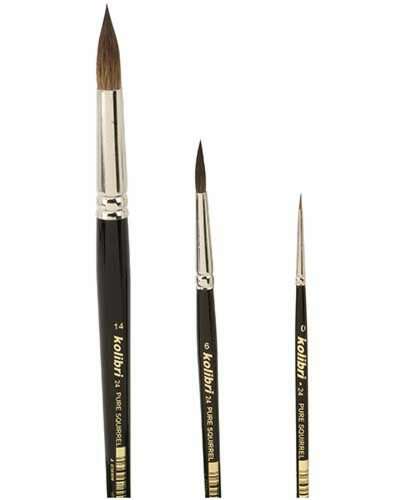
Richard Symonds (1617–1660) was an English royalist, antiquary, and amateur artist who is now remembered for his eyewitness diary of events of the First English Civil War. His Italian notebooks are an important resource for painting techniques of the 17th century.
By Mary Beal
While Symonds’ comment on paint boxes remain unique, many treatises contained information on brushes, as Harley has shown in her excellent article, which provides good illustrations of the brushes used.(20) Although several writers, such as Armenini,(21) described how to make brushes these were usually bought, possibly from those shops or “botteghe” selling assorted lengths of canvas described by Symonds.(22) Brushes fell into two categories: bristle ones made from hogs’ hair (“setola”), and those made from finer hair, like the polecat (“puzzola”), miniver (“vaio”) and badger brushes (“tasso”). These were all listed by Symonds.(23) The hair usually fitted into a quill in which was inserted a handle of bone or wood. Symonds’ observations are of particular value because he described exactly how Canini employed each type of brush. Each type of brush will be examined in turn, starting with the bristle brush.
Although less flexible than soft hair brushes, Cennini, Armenini and De Mayerne all stressed that the bristle brush should be neither excessively coarse nor hard. One way to break in a new bristle brush was to whitewash a wall with it;(24) another way was to rub the brush hard on a tile.(25) Sizable bristle brushes were used by many artists to apply their ground and map out the first broad area of colour in their pictures. Henry Gyles for example recommended: “Pencills of a pretty large size made of swines hair for putting in your ground abut yor pictures. Likewise greater brushes made of hoggs bristle to prime your boards & to paint frames wthall for your pictures.”(26) Similar instructions were give by De Mayerne. For sketching out landscape paintings, he prescribed the softest bristle brushes available, adding that short thick ones were best for that purpose.(25) De Mayerne’s comments corresponded closely to Symonds’ observations. In the following passage, Symonds noted that the landscape background of Canini’s picture “Anthony and Cleopatra” was blocked out with several bristle brushes: “For a ground for the light clouds Biacca & Terra gialla mingled together uniting these two grounds with his large pencill of Setola wth which both were layd on… The Trees below ye montaynes & behind the Shippe & wch are behind the smoake of the incense, he sbozzod (sketched in) wth Terra Verde giallo santo & negro Carbone uniting all wth his pencill of Setola & covering all the cloth… The Bridge he coloured thus, first layd patches as broad as one’s hand of a mixture where Terra Rosa prvayld, … then uniting alltogeather wth a large pencill of setola.”(27) This detailed account is supplemented by Symonds’ description of the portrait of Thomas Killigrew. For this painting, Canini made extensive use of bristle brushes, chiefly at the beginning to block in the light and shadow of the face, and to paint broad areas of hair, apparel and background: “wth a pretty large pennello of setola… dipping in the lacca terra giallo & cinabro layd on the principall lumi of the forehead & cheeks… ye mezze tinte… uniting & working both together wth ye same pencill of setola… he made the masse of the haire on the darke side & all the darkes unting bothtthe chiari, & scuri wth the same pensill of setola… Then united the Campo wch was of divers sad imbroyd colours but a blackish green prvayld, united the haire with it all, wth large pencills of setola… Next day painting the hand, first after the Tinta’s made & the scuri & contorni made of Lacca laying all in their places wth the middling sizd pencills of setola uniting all… His colouring his black cloth suit… uniting & adding pleates & Wrinkles all wth pretty large penello of setola.”(28)
Like bristle brushes, polecat brushes were popular. Harley has pointed out that the polecat, “mustel putorius”, is the ferret in its wild states Its hair made a softer more supple brush than did hog’s bristles so it was suitable for blending different colours together. For example after Canini laid in the lights and shades of the face of Killigrew with a bristle brush, he started to soften carefully these harsh contrasts with several quite large polecat brushes: “Then a middling penello of Puzzola he united the mouth & lipps gently… he united & sfumd the cheeks making the tenerezza of the Flesh, also of the forehead… With a dry large pencill of Puzzola… sfuming all the face over... He tooke a fresh pencill of Puzzola finishing finissime sfumd all the face & mouth gently & sweetly spending much time in so doing.”(28) Canini’s polecat brush may have been identical to the “Great Fitch Pencil” described in “The Excellency of Pen and Pencil”. Harley showed that “fitch” was a general term for square headed brushes in the seventeenth century; but she added that originally the word meant polecat or polecat brush. In any case, when Symonds’ description above of the polecat brush is compared to that of the “Great Fitch Pencil”, it is clear that these brushes had the same function: “Having put in all your colours both light and dark, take the great Fitch pencil… and sweeten the colours therewith by sweetening is meant the going over these several shadows thus laid with a soft Pencil which with orderly handling will drive and intermix the Colours one into another, that they will appear as if they were all laid on at once and not several times. If this great fitch’d Pencil be too big, you may use a lesser, but note, that the bigger Pencils you use, the sweeter & better your will work will lie, and it is ease to handle a great Pencil as a little one, if you use yourself to it.”(29)
Blending in oil painting was not only carried out with soft polecat brushes. Large, somewhat flat ended badger brushes were, and still are, used at this stage. Symonds observed that Canini chose a badger brush to soften the background of his portrait of Robert Spenser: “He having intreccht (painted waves) upon the haire first uniting haire & field wth a large pencill of Tasso.”(30) However, as this is the only occasion on which Symonds mentioned a badger brush, it is likely that Canini preferred polecat brushes for this purpose.
The only other brush mentioned by Symonds was made of “miniver”, a name thought to signify ermine or a mixture of ermine and weasel. Miniver brushes varied in shape and size, but many were fine and pointed for delicate work, as Cennini explained: “Miniver brushes of several types are needed: some for gilding, some for working with the flat of the brush, and these should be trimmed off a bit with the scissors, and stropped a little on the porphyry slab to limber them up a little; one brush out to be pointed, with a perfect tip for outlining; and another ought to be very thin for special uses and very small figures.”(31) Canini employed these for similar purposes. Symonds noted that Canini chose miniver brushes (which he called mistakenly “varo” and not “vaio” throughout), for fine outlines and finishing touches of intense dark and light in his Killigrew portrait:
“Wth a pencill of Varo & lake made the scuri of the mouth.. Doing the fyne darkness of the eyebrows wth a pencill also of varo… Then wth a fyne pencill wth lacca & Negro d’osso / Carbone made the deep shadowes of ye haire next the face… laying scuri of the fingers where need was of deeper scuri with a penc. of Varo fino… wth pencills of Varo layd on the deep scuri of the little shadowes. It servd also for the riflesso of the fingers, helping now & then adding brighter the… reflexes.”(28) The miniver brushes used for this portrait were probably very small, but longer ones were also popular. Canini told Symonds that Mario de’ Fiori, the flower painter, chose “all soft & long pencills of the finest,”(32) and later Symonds commented that the “long pencills of Varo such as Mario de Fiori uses… were good for leaves & best for a face.”(23)
He added that “Those that make barkes also have long pensills on purpose to draw cords”, presumably meaning that long miniver brushes were suitable for painting in the fine rigging of ships in seascapes.(23)
All the types of brush mentioned above were tested and treated with great care. Unlike De Mayerne,(25) Symonds did not recommend squeezing a soft hair brush between the fingers to make a point. Instead he claimed that when new, such brushes could be daubed in oil paint which, after it had dried, would “fasten (the brushes) close”.(23) At the end of a painting session, many artists washed their brushes in soap and water, which Symonds was warned might make them hard. He pointed out that brushes were sometimes dipped in olive oil (“common oyle”) which kept them moist and soft because it did not dry. Other painters cleaned their brushes in turpentine, nut and linseed oil, and according to Symonds, spike oil removed “ye color… attached to (brushes) lying long-uncleansd.”(33) Symonds observed that when clean, brushes were wrapped in paper soaked in spike oil to preserve them from moths; and he noted Vitruvius’ claim that cedar oil was an equally good preservative.(34) To ward off moths, De Mayerne similarly recommended either soaking brushes in spike oil or swathing them in strong smelling herbs, such as tobacco.(25)
Notes
20. R. Harley “Artists’ Brushes—Historical evidence from the sixteenth to the nineteenth century,” IIC Lisbon Congress 1972. Conservation of Paintings and the Graphic Arts, p. 123–126.
21. Armenini Bk II Ch VII p. 157–159.
Reference
Reproduced from Mary Beal’s doctoral thesis, A Study of Richard Symonds, p. 73–79.












